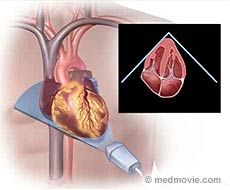The Most Common Heart Ultrasound: Transthoracic Echocardiogram
FREQUENTLY ASKED QUESTIONS ABOUT HEART ULTRASOUND (ECHOCARDIOGRAPHY)
![]() Click here to view a Heart Ultrasound
Click here to view a Heart Ultrasound
What is heart ultrasound?
 Heart ultrasound provides your doctor with moving images of your heart and takes excellent pictures that will help your doctor evaluate your heart health. The most common type of heart ultrasound is non-invasive and very easy on the patient. A specially trained technician, called a cardiac sonographer, uses a gel to slide a microphone-like device called a transducer over the chest area. This allows reflected sound waves to provide a live picture of your heart and valves. Heart Ultrasound uses the same technology that allows doctors to see an unborn baby inside a pregnant mother. No radiation is involved in heart ultrasound, and the technology can be used on people of all ages.
Heart ultrasound provides your doctor with moving images of your heart and takes excellent pictures that will help your doctor evaluate your heart health. The most common type of heart ultrasound is non-invasive and very easy on the patient. A specially trained technician, called a cardiac sonographer, uses a gel to slide a microphone-like device called a transducer over the chest area. This allows reflected sound waves to provide a live picture of your heart and valves. Heart Ultrasound uses the same technology that allows doctors to see an unborn baby inside a pregnant mother. No radiation is involved in heart ultrasound, and the technology can be used on people of all ages.
Why might I need a heart ultrasound?
You may benefit from this if you’ve experienced unexplained chest or upper arm pain, a heart murmur, a heart attack, a heart defect, and/or a history of heart disease, though there are many possible reasons that your doctor may want to evaluate your heart health.
What is a heart ultrasound (transthoracic echocardiogram;TTE; echocardiogram; echo)?
A heart ultrasound is a useful tool to evaluate the structure and function of the heart and associated vessels. It is a fast, easy and painless evaluation that uses ultrasound waves to produce images of the heart. In North America, the test is performed by a specially trained technologist, called a sonographer, and is interpreted by a specially-trained physician, usually a cardiologist, trained in reading heart ultrasounds. Heart Ultrasounds provide your doctor with moving pictures of your heart that allows your doctor to evaluate your heart’s health. This ultrasound uses the same technology that allows doctors to see an unborn baby inside a pregnant mother.
Why has my doctor requested that I have a heart ultrasound (echocardiogram)?
There are many reasons that your physician may request that you have a heart ultrasound. Physicians use it evaluate your heart’s performance as well as the structures of the heart, including the heart chambers and valves. An echo may sometimes also be used to look for the cause of a murmur, to check the size of the heart chambers, to check for fluid around the heart, or to inspect the pumping capability (the muscles) of the heart if a patient has short of breath or has complained of certain symptoms during exertion.
How do I prepare for an echo?
There is no special preparation required for a heart ultrasound. You should come as you are and eat or drink as you normally do. If you take medications, you should continue to take them as normal unless your doctor specifies otherwise. You should plan on being at the echocardiography lab for about 45 minutes to one hour.
What should I expect?
Upon arrival at the lab the friendly staff will greet you. They may request you to provide additional insurance information, and will ask you to register. They may also ask that you provide a prescription or order for your exam.
You will then be escorted into an ultrasound room. The room will be dimly lit and will contain an examination table or bed and an ultrasound machine. You may be asked a few questions by the sonographer who will want to know why you are having the test, if you have had previous tests, and if you have ever had open heart surgery. Usually a brief explanation of the procedure will be given as well.
You will be asked to remove your clothing from the waist up and women will be given a gown to wear during the procedure. If you need help, the sonographer will assist you in getting onto the exam table, where you will be asked to lie on your left side. The sonographer will then attach ECG lead wires to electrodes adhered to your chest with simple medical tape.
The lights may be dimmed to allow the sonographer to see the monitor better.
The sonographer will apply ultrasound gel to a microphone-like device called a transducer. The transducer sends and receives the harmless ultrasound waves. The gel allows the ultrasound beams to penetrate your chest wall so that it is possible to “see” your heart.
Next, the sonographer will begin to acquire ultrasound images and audio recordings by methodically and precisely moving the transducer around on your chest, stomach, and neck. The sonographer will be viewing these images on a monitor and will take various recordings at several different locations or “views”. During recording, you may be asked to change your position and to hold your breath. These variations in position and breathing allow the Sonographer to obtain the best quality pictures. The sonographer will press the transducer against your skin and this pressure may be moderate at times to facilitate the transmission of ultrasound waves. If it becomes uncomfortable, please let the sonographer know.
You should try to remain still and quiet during the exam. The imaging will take about 30 to 45 minutes. Often, the sonographer will review the study with a supervisor or physician while you are still in the room. You should not be alarmed; the technique to acquire images of the heart is technicallydemanding and sonographers frequently rely on the advice of others as they acquire these images.
The images and sounds of the exam will be recorded on a computer disk and/or videotape for later review.
What will I see and hear on the heart ultrasound machine during my exam?
Ultrasound waves used in performing the echocardiogram are not audible to the human ear, so you will not hear the sound waves. Structures will be displayed in “real-time” and appear as white moving objects on the screen. For example, the valves of the heart will look like white flap-like moving structures. Areas of the heart where there is fluid or blood look black on the screen.
During the exam, you will notice the sonographer placing marks on the screen with small computer calipers. The sonographer uses the calipers to perform various measurements of the size, function and blood flow of the heart.
An echocardiogram exam usually includes a Doppler recording of the blood movement or flow within the heart. When color flow Doppler is used in the exam it will appear as different colors moving within the white and black images on the monitor. The different colors represent the different speeds and directions of blood flow in the heart.
Doppler examinations often also include an audio signal of the blood flow. These audio signals can be heard and seen. During the audio Doppler recording, you will hear the sound of the blood moving through the heart and the sound of the heart valves opening and closing. The audio signals are also displayed as a graph on the monitor. These graphic recordings help the physician to determine valve function and heart pressures.
What happens after the exam?
Following the recording of the images, the sonographer will remove the ECG electrodes from your chest, will wipe off the ultrasound gel from your skin, will help you off the examination table and escort you out of the lab.
The ultrasound images and Doppler recordings will be submitted to a cardiologist who is a specially-trained physician in reading heart ultrasounds. He or she will interpret the images and will then provide your general physician with a written report. Often, you will not be given any results for one or two days. Generally, the sonographer will not provide you with any results at the time of the examination.








